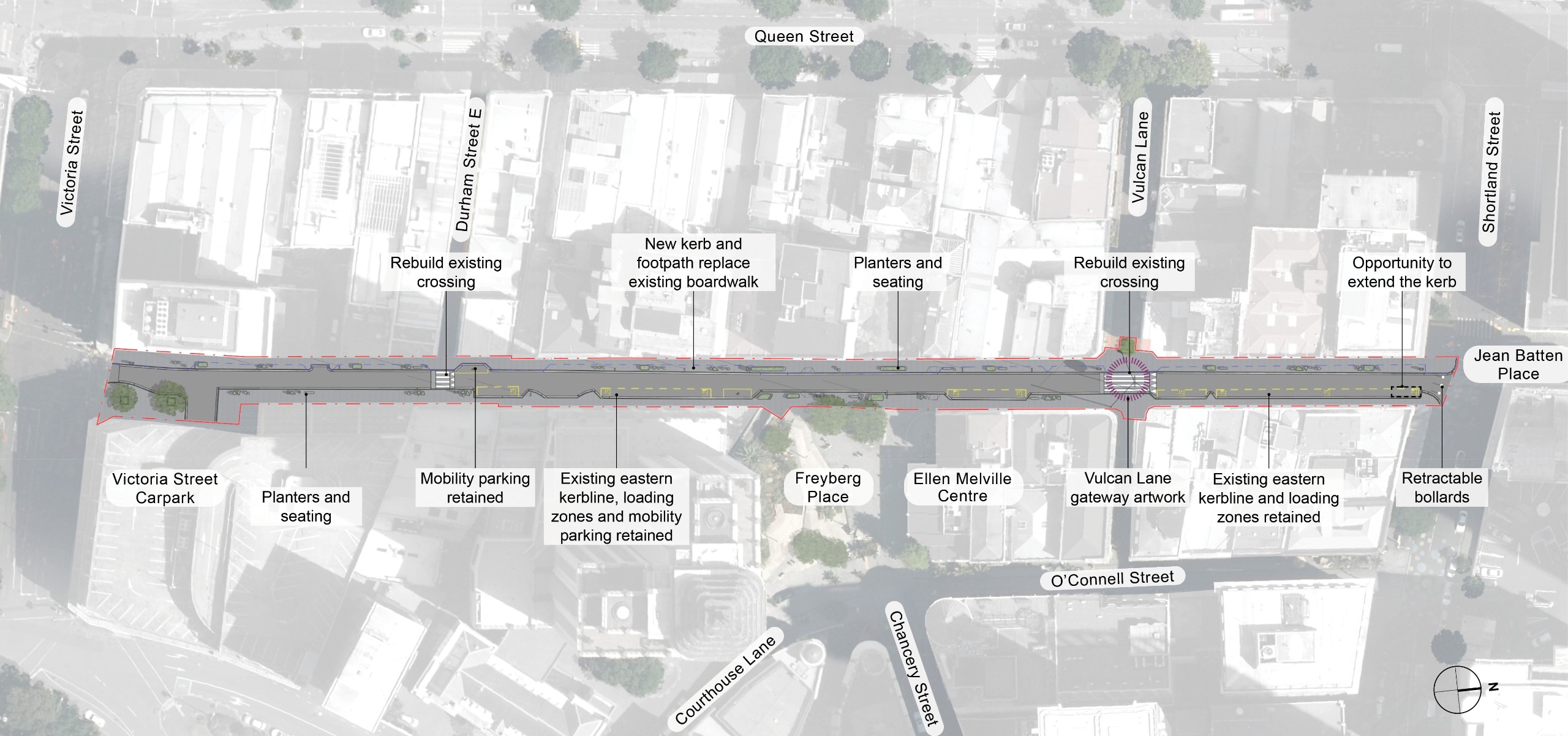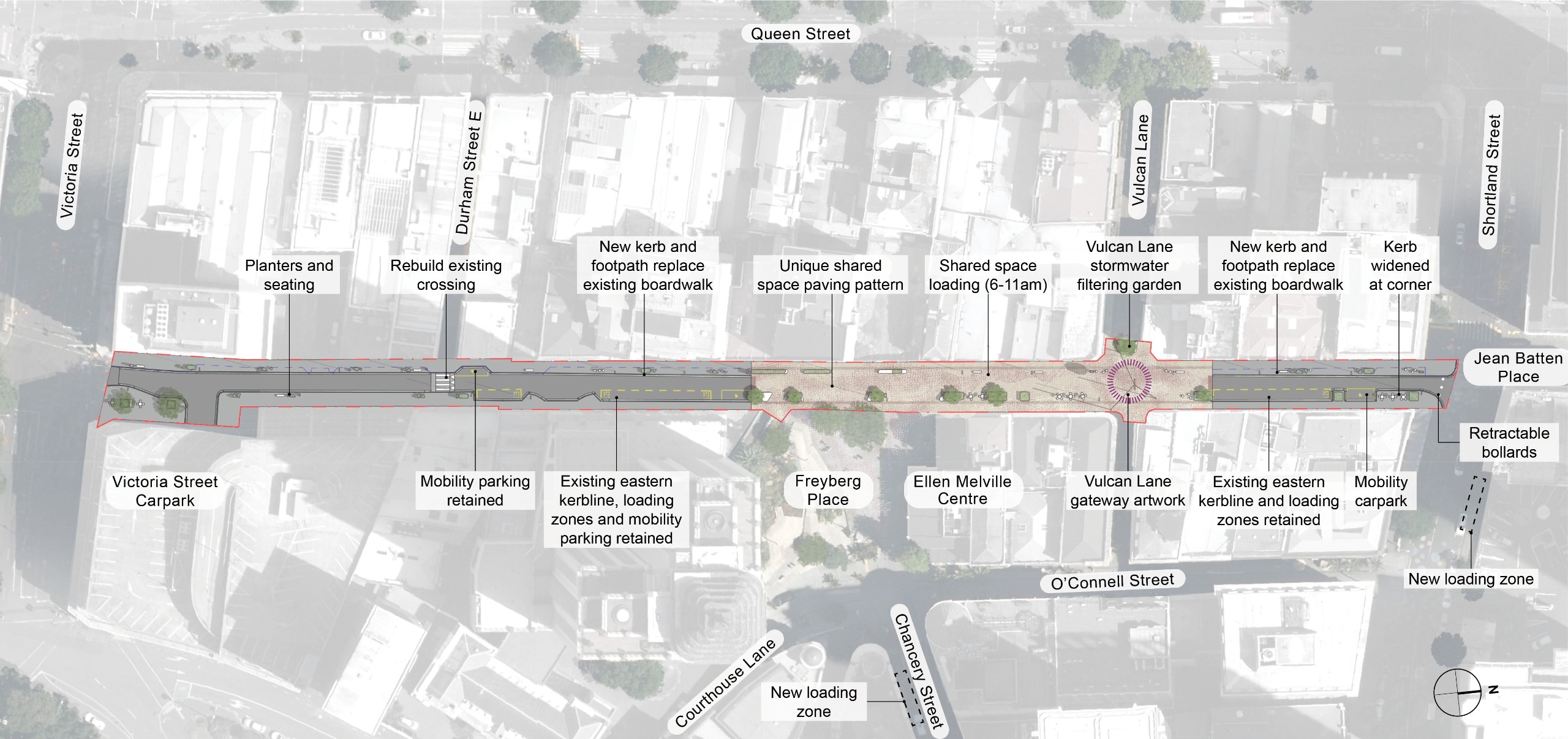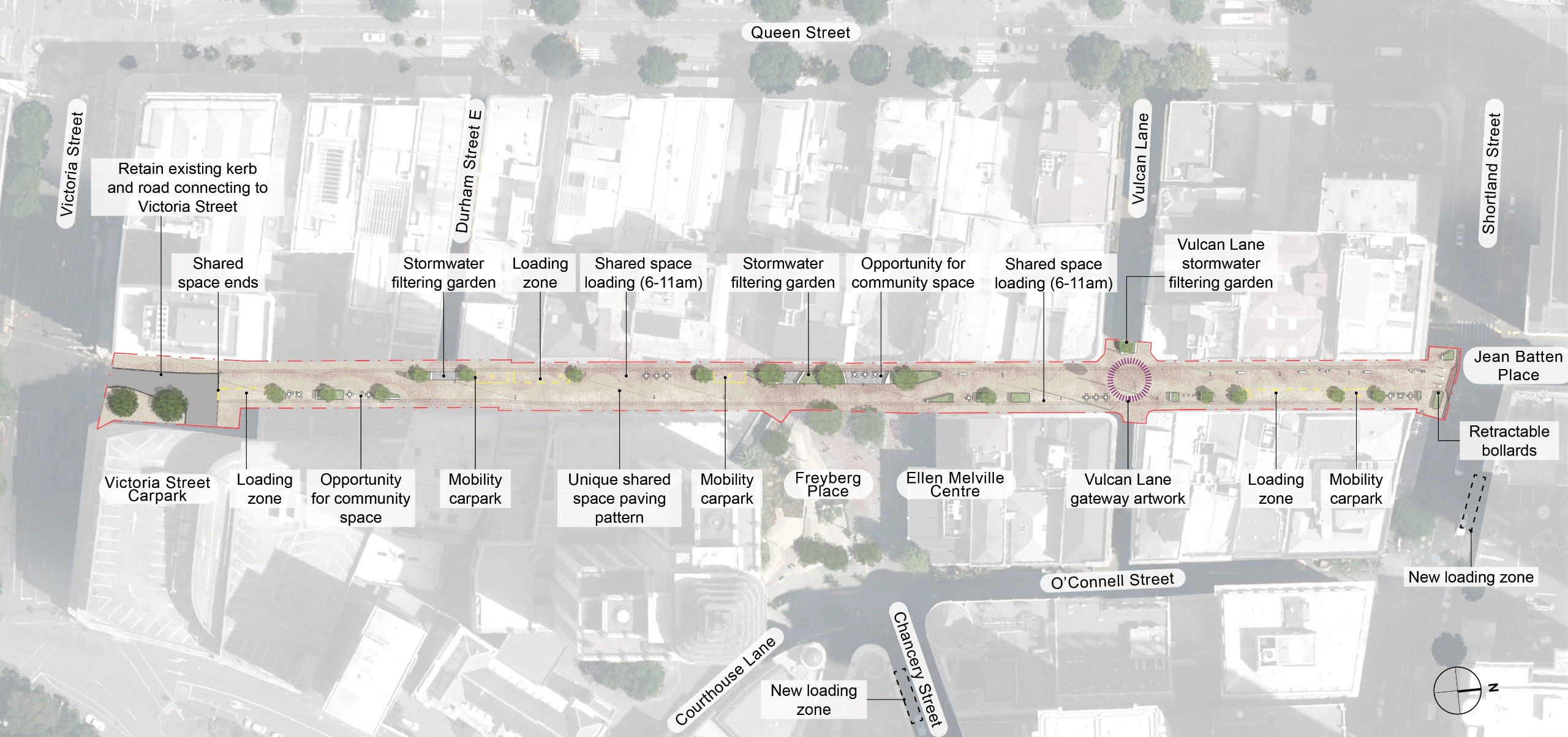Vibrant street
You want High Street to feel alive, with buzzing shops, quality places to eat, drink and shop.

On 21 July 2025, we shared three design ideas for High Street’s future, shaped by what we heard from the community in 2024. Engagement on the ideas closed on 18 August 2025.
Thank you to everyone who provided their input. What we heard will help guide the next steps in the design process.
High Street is one of the busiest laneways in the city centre. It’s a place people come to shop, dine, commute and meet friends. It also connects into a growing network of upgraded laneways like O’Connell Street, Jean Batten Place and Freyberg Place.
In 2020, we made some improvements to make the street more welcoming and easier to get around. These updates helped shape how people use High Street today.
Now, as we plan for more people to live, work and visit the city centre, we’re building on that foundation to plan for High Street’s future.
Funded by the city centre targeted rate, this project is part of a wider transformation happening across midtown and supports the City Centre Masterplan vision of a vibrant, connected and people-focussed city centre.
This is our chance to give High Street the care it deserves and reinforce its role in a growing, changing city centre.
Tāmaki Makaurau is transforming.
The opening of the City Rail Link Te Waihorotiu Station is just around the corner. It's set to become the busiest train station in the country, bringing thousands of people into midtown each day.
Additionally, projects like Te Hā Noa on Victoria Street and improvements to Wellesley and Albert Streets are reshaping how people move, gather and spend time in the city.
High Street plays a key role in this transformation. It’s more than just a connection – it’s a destination, full of local character, history and energy.
As our city grows, this is our opportunity to ensure High Street grows with it – supporting how people live, work and connect now and into the future – while retaining the things people love about it today.
We’re working in partnership with Ngāti Whātua Ōrākei, Te Ākitai Waiohua and Ngāti Te Ata Waiohua.
They have provided a matawhānui (broad vision) and four uara (values) for the project that have informed the ideation process and continue to guide the project’s approach.
Te pai me te whai rawa
Enabling wellbeing and prosperity for High Street as part of the city centre
Recognise the uniqueness of High Street by drawing together its many pasts and futures to create a place for life and community to prosper at the heart of our city.
Tirotiro ki Mua - meeting the future
Recognise the challenges facing us and respond in ways by which we demonstrate our accountability to future generations through innovative, flexible and resilient solutions.
Tiaki Waitematā Kupenga Rau - Elevate the mana and mauri of our collective taonga, Waitematā Kupenga Rau
Prioritise the wellbeing of the Waitematā harbour.
Te Kānohi Kītea - enduring presence of tangata whenua
Ensure the mana, tikanga and mauri of tangata whenua is authentic and is present.
He Wāhi mō te katoa - a place open and inviting for all
Create high quality and humane spaces for all to dwell, spell and experience, which encourage: the ‘soft echo of shared humanity’ to be present a ‘supported’ democratic space available for our diverse communities to gather, celebrate and enjoy.
Between July and October 2024, we heard nine community aspirations for High Street’s future – through conversations with local businesses, residents and visitors – and surveys with the wider public.
These aspirations shaped the three design ideas we shared and continue to guide the project. Together, they paint a picture of a vibrant, people-friendly street that supports daily life, celebrates local character and evolves with the city.You want High Street to feel alive, with buzzing shops, quality places to eat, drink and shop.
You want it to be easier and safer to walk, with better footpaths and more space for people.
You want space to come together - whether it’s for events, markets or somewhere to sit and enjoy the city.
Between July and August 2025, we shared and engaged on three design ideas for High Street’s future.
Click through the three tabs below to explore each idea.
Click on the icons to view more detail and sketches of what it could look like.
A lighter-touch idea that largely keeps the street’s current layout and look, makes the existing footpath extensions more durable and includes targeted upgrades to help the street function better.

Click on the icons to view key features of the design and sketches of what it could look like.
Click the arrows in the top right corner to expand the image.
Retains current feel
Targeted upgrades to refresh the street
Better walking experience
More space when people need it
A balanced idea that upgrades the central block around Freyberg Place into a kerbless shared space that can be used flexibly. The rest of the street largely keeps its current layout and look, makes the existing footpath extensions more durable and includes targeted upgrades to help the street function better.

Click on the icons to view key features of the design and sketches of what it could look like.
Click the arrows in the top right corner to expand the image.
Retains current feel, providing more space for people
Better walking experience
More space when people need it
Reflects unique identity
More welcoming
|
A transformational idea that upgrades the full length of High Street, from Shortland Street to the Victoria Street carpark, into a pedestrian priority shared space, with new pavements, greenery and street furniture.

Click on the icons to view key features of the design and sketches of what it could look like.
Click the arrows in the top right corner to expand the image.
A street that’s made for people
Better walking experience
Safer and more welcoming
More space when people need it
Green and cared for
Reflects unique identity
Stronger connections
Engagement closed on 18 August 2025
We’re currently reviewing the feedback to help shape a preferred future for High Street.
Later this year, we’ll share what we heard from the community and outline the next steps.
In early 2026, we’ll present a preferred direction to elected members, informed by the feedback from businesses, residents, and visitors throughout the engagement.
Together, we’re aiming to identify the preferred future for High Street:
If you have questions or want to learn more about the project, please contact us:
| highst@aucklandcouncil.govt.nz |
Have questions or want to learn more about a project? Contact us:
| Name | AK Have Your Say |
|---|---|
| akhaveyoursay@aucklandcouncil.govt.nz |
This site is owned and operated by Auckland Council using software licensed from Social Pinpoint. For details on how Auckland Council collects and protects your personal information, refer to their Privacy Policy. For details of how Social Pinpoint may access personal information, please refer to Social Pinpoint’s Privacy Policy.
The following Terms and Conditions govern the use of AK Have Your Say (“the site”). The software platform is owned by Social Pinpoint Pty Ltd and operated by us, Auckland Council.
By accessing and using this site, you are choosing to accept and comply with the Terms presented throughout this agreement as well as the Privacy Policy and Moderation Policy. These Terms apply to all visitors and users of this site. Linked sites, affiliated services or third party content or software have their own Terms that you must comply with. If you disagree with any of the Terms presented in this agreement, you may discontinue using the site immediately.
If you are under 18 years old, please ensure that your parent or guardian understands and accepts these Terms and Conditions (including the Privacy Policy and Moderation Policy).
What are the conditions with a user’s account?
While using the site, you must not violate any applicable laws and regulations. It is our duty to protect the confidentiality of content you provide on our site in accordance with our Privacy Policy. When you create an account with us, you must always provide us with accurate information. Failure to provide accurate information violates the Terms, which may result in immediate termination of your account on our service. You are responsible for protecting your own password you use for this site and for any activities done under that password. Unauthorised use of your password or account must be immediately reported to us. In some cases, we or our agents may require access to your user accounts to respond to technical issues.
We are not responsible for the content on the site that has been provided by the users of the site. Any content posted by you is subject to the rules of our Moderation Policy. Your contribution to the site may be edited, removed or not published if we consider it inappropriate (refer to Moderation Policy). Contributors should also be aware that their posts may remain online indefinitely. Where practical, you may choose not to identify yourself, deal with us on an anonymous basis or use a pseudonym.
What do we require from our users?
You must understand and agree that, without limitation:
Can your account be suspended or terminated?
We may terminate or suspend access to your site and/or account immediately, without prior notice, including without limitation if you breach the Terms. We may immediately deactivate or delete your account and all the related files and information in your account. After your account has been terminated, the content you have posted may also remain indefinitely on the site.
If you want to terminate your own account, please send an email to enquiry@aucklandcouncil.govt.nz.
Governing Law
These Terms shall be governed in accordance with the laws of North Island, New Zealand, without regards to its conflict of law provisions.
Indemnification
Auckland Council, its subsidiaries, affiliates, officers, agents, licensors and other partners are not responsible for any loss, liability, claim, or demand, including legal fees, made by any third party due to or arising from a breach of this agreement and/or any breach of your representations and warranties set forth above.
What content do we own?
This website contains the copyrighted material, trademarks, patents, trade secrets and other proprietary information (“Intellectual Property”) of <client> and its suppliers and licensors. Auckland Council owns and retains all proprietary rights in the intellectual property. All intellectual property in the content of this site including without limitation to text, software, source code, pages, documents and online graphics, photographs, sounds, audio, video and other interactive features are owned by or licensed to us.
Any original content that you submit or post on our site may be made available to the public and allows users to share your content (with the end user acknowledging your contribution) under the Creative Commons Attribution-ShareAlike 4.0 Australian License.
Except for Intellectual Property which is in the public domain or for which you have been given written permission, you may not copy, alter, transmit, sell, distribute any of the Intellectual Property on this site.
We are not responsible for your communications or dealings, including payment and delivery of goods or services, with a third party found via our website. Any loss or damage incurred from those communications or dealings are solely between the user and the third party.
Disclaimer and Warranties
Users must agree that you use of the site is at your own risk. We make no warranty that the site will meet your requirements or be uninterrupted or error-free. Any material that the user downloads through the site is done at their own risk and are responsible for any damages to their computer system or loss of data.
What happens if these Terms change?
We reserve the right, at our sole discretion, to modify or replace these Terms at any time without notice. The most recent version of the Terms can be seen on this page. By continuing to access or use our site after those revisions become effective, you agree and will comply to the revised terms. If you do not agree to the revised terms, please discontinue using our site.
Contact Us
If you have any questions about these Terms, please contact us at enquiry@aucklandcouncil.govt.nz
Enter your email address below. We will send you instructions to reset your password.
Back to Log in
Your privacy is important to us and is protected – your contact details will be kept confidential and will only be used to update you about the project(s) you have given feedback on.
Already have an account? Log in now
Thank you, your account has been created.
Completing the questions below helps us better understand the diverse range of people who contribute their ideas. The questions are optional.
You’re using an outdated browser.
Some features of this website may not work correctly. To get a better experience we strongly recommend you download a new browser for free:
Would you like to follow this project to receive email updates?